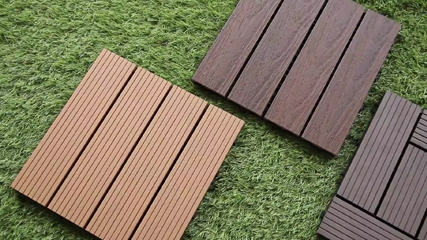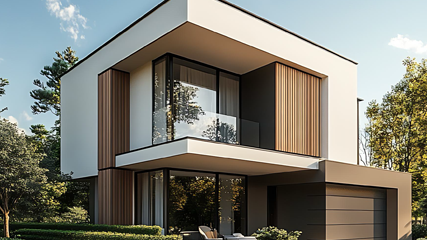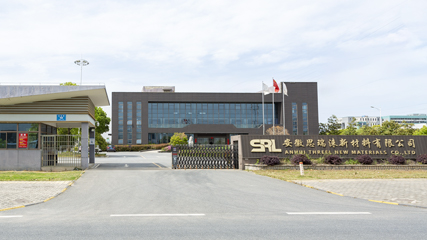1.Introduction to WPC Wall Cladding
1.1 What is WPC (Wood Plastic Composite)?
Wood Plastic Composite, commonly known as WPC, is an innovative building material made by combining natural wood fibers or wood flour with thermoplastics such as polyethylene, polypropylene, or PVC. This unique blend results in a composite that captures the natural look and feel of wood but comes with enhanced durability and resistance to many of wood’s common drawbacks. WPC is engineered to be strong, weather-resistant, and low-maintenance, making it an excellent alternative to traditional wood in various applications.

1.2 Why Choose WPC for Wall Cladding?
Wall cladding plays a crucial role in both the aesthetics and protection of a building’s exterior and interior walls. Choosing the right material for cladding can greatly impact the building’s durability, maintenance requirements, and overall appearance. WPC wall cladding offers several advantages over conventional materials:
Durability: Unlike natural wood, WPC is resistant to rot, decay, and insect attacks.
Moisture Resistance: WPC can withstand exposure to moisture without warping or swelling.
Low Maintenance: It requires minimal upkeep, eliminating the need for frequent painting or sealing.
Eco-Friendly: Many WPC products are made using recycled materials, reducing environmental impact.
Design Flexibility: WPC cladding comes in various colors, textures, and finishes, offering a versatile aesthetic for any design style.
1.3 Applications of WPC Wall Cladding
Thanks to its durability and versatility, WPC wall cladding is suitable for a wide range of applications, including:
Residential Buildings: Enhancing the look and protection of homes with stylish interior and exterior panels.
Commercial Buildings: Providing a durable facade solution that withstands heavy use and weather exposure.
Feature Walls: Creating eye-catching accent walls that add texture and warmth to interiors.
Outdoor Spaces: Suitable for patios, garden walls, and outdoor kitchens due to its weather-resistant properties.
2.Benefits of WPC Wall Cladding
2.1 Durability and Longevity
One of the standout benefits of WPC wall cladding is its exceptional durability. Unlike traditional wood, WPC is engineered to resist common forms of damage such as rot, warping, cracking, and splintering. This makes it an ideal choice for both interior and exterior walls exposed to harsh weather conditions. With proper installation, WPC cladding can last for decades, maintaining its structural integrity and appearance over time.
2.2 Moisture Resistance
WPC’s composite makeup gives it excellent resistance to moisture, a common enemy of natural wood. This moisture resistance prevents swelling, shrinking, and decay, which often result from prolonged exposure to rain, humidity, or damp conditions. This property makes WPC especially suitable for use in bathrooms, kitchens, and exterior cladding where moisture levels are consistently high.
2.3 UV Resistance
Exposure to sunlight can cause fading and deterioration in many materials. WPC wall cladding is designed with UV stabilizers that protect it from harmful ultraviolet rays, ensuring that its color and surface texture remain vibrant and intact for years. This UV resistance helps maintain the aesthetic appeal of buildings while reducing the need for frequent repainting or refinishing.
2.4 Low Maintenance
Unlike wood, which requires regular sanding, painting, or staining, WPC wall cladding is remarkably low maintenance. Routine cleaning with water and mild detergent is usually sufficient to keep it looking new. Its resistance to mold, mildew, and insects means fewer repairs and less upkeep over its lifetime, saving both time and money for homeowners and builders alike.
2.5 Eco-Friendly and Sustainable
WPC is considered an environmentally friendly building material because it often incorporates recycled wood fibers and plastics, reducing waste and minimizing reliance on virgin materials. Additionally, its long lifespan means fewer replacements and less material consumption over time. By choosing WPC, builders and homeowners contribute to more sustainable construction practices.
2.6 Aesthetic Appeal and Design Flexibility
WPC wall cladding is available in a wide range of colors, textures, and finishes that mimic the natural look of wood or offer entirely new modern designs. This flexibility allows architects and designers to create unique, stylish walls that complement any architectural style—from rustic and traditional to sleek and contemporary. WPC panels can be customized to suit individual tastes and project requirements.
3.Types of WPC Wall Panels
3.1 Interior WPC Wall Panels
Interior WPC wall panels are designed specifically for indoor use, offering an attractive and practical alternative to traditional wood or drywall finishes. These panels provide excellent insulation, soundproofing, and aesthetic appeal. Thanks to their resistance to moisture and pests, they are ideal for spaces such as living rooms, kitchens, bathrooms, and commercial interiors where durability and easy maintenance are important. Interior WPC panels come in a variety of finishes, including wood grain textures and smooth surfaces, allowing seamless integration with different décor styles.
3.2 Exterior WPC Wall Cladding
Exterior WPC wall cladding is engineered to withstand harsh weather conditions, including rain, UV exposure, and temperature fluctuations. These panels are thicker and more robust compared to interior options to provide long-lasting protection to building exteriors. Their moisture-resistant and UV-stabilized properties prevent warping, fading, and cracking over time. Exterior WPC cladding is often used on residential homes, commercial buildings, and outdoor structures to improve curb appeal while enhancing durability and weather resistance.
3.3 Different Styles and Finishes
WPC wall panels come in a broad range of styles, colors, and textures to suit various architectural and design preferences. Common finishes include:
Wood Grain: Mimics the natural look and feel of real wood with textured grains and knots.
Smooth: Offers a modern, sleek appearance suitable for minimalist designs.
Grooved and Ribbed: Adds dimension and visual interest, often used in feature walls or accent areas.
Colored Panels: Available in natural wood tones as well as vibrant colors to complement any design scheme.
4.Installation of WPC Wall Cladding
4.1 Preparing the Wall Surface
Proper preparation of the wall surface is essential for a successful WPC wall cladding installation. Start by cleaning the surface to remove dust, dirt, grease, and any loose materials. The wall should be dry, flat, and structurally sound. Any cracks or holes should be repaired before installation. For exterior applications, it’s also important to install a moisture barrier or waterproof membrane to prevent water ingress behind the panels.
4.2 Cutting and Fitting WPC Panels
WPC panels are easy to cut and shape using standard woodworking tools such as saws and drills. Measure the wall carefully and cut the panels to the required sizes. To ensure a neat finish, make precise cuts and consider the expansion gap recommended by the manufacturer (usually a few millimeters) to accommodate thermal movement. Test-fit the panels before permanent fixing to ensure proper alignment and spacing.
4.3 Fastening Methods (Screws, Clips, Adhesives)
There are several ways to fasten WPC wall cladding, each suited for different applications and preferences:
Screws: Using corrosion-resistant screws is a common method. Pre-drill holes to avoid splitting and countersink screws for a flush finish.
Clips: Hidden fastening clips provide a clean, seamless look by securing panels without visible screws.
Adhesives: In some cases, strong construction adhesives can be used, especially on smooth and stable surfaces, but mechanical fasteners are generally recommended for long-term durability.
4.4 Step-by-Step Installation Guide
Prepare the wall: Clean and repair the surface; install a moisture barrier if necessary.
Measure and mark: Plan the layout, marking where each panel will go.
Cut panels: Cut panels to fit, allowing for expansion gaps.
Install starter strips: Attach starter strips or profiles to help align the first row.
Fix panels: Secure panels using screws, clips, or adhesives according to the chosen method.
Continue installation: Work row by row, ensuring panels fit tightly and evenly.
Finish edges: Use trim pieces or corner profiles to give a polished look.
4.5 Tools and Materials Needed
To install WPC wall panel, you will typically need:
Measuring tape and pencil
Level and straight edge
Saw (circular or handsaw)
Drill and screwdriver bits
Corrosion-resistant screws or fastening clips
Construction adhesive (optional)
Safety gear (gloves, goggles)
Moisture barrier membrane (for exterior walls)
Trim and finishing profiles
5.Maintenance and Care
Proper maintenance is key to ensuring that WPC wall cladding remains attractive and functional for many years. Fortunately, one of the biggest advantages of WPC is its low maintenance requirements compared to traditional wood or other cladding materials. Here’s a guide on how to care for your WPC wall cladding effectively:
5.1 Cleaning WPC Wall Cladding
Keeping WPC panels clean is simple and requires minimal effort. Regular cleaning helps prevent dirt buildup and maintains the material’s aesthetic appeal. To clean WPC cladding:
Use a soft brush or cloth to remove dust and loose dirt.
Wash the surface with mild soap and water using a sponge or soft-bristle brush.
For stubborn stains, a diluted household cleaner or vinegar solution can be applied.
Avoid harsh chemicals or abrasive cleaners that can damage the surface.
Typically, cleaning once or twice a year is sufficient unless the cladding is exposed to heavy dirt or pollution.
5.2 Preventing Mold and Mildew
Though WPC is resistant to moisture, mold and mildew can occasionally form in damp or shaded areas, especially outdoors. To prevent this:
Ensure proper ventilation around the cladding.
Regularly remove debris like leaves or dirt that can trap moisture.
Clean affected areas promptly using a solution of water and mild detergent or a mold remover designed for composite materials.
Avoid installing WPC panels in areas with poor drainage or constant water exposure.
5.3 Repairing Minor Damage
While WPC is durable, minor damages such as scratches, dents, or small cracks can happen during installation or use. Here’s how to handle them:
Light scratches can often be buffed out using fine sandpaper.
Small cracks or chips can be filled with a composite filler or sealant compatible with WPC.
For more significant damage, replacing the affected panel might be the best solution to maintain appearance and structural integrity.
6.Design Ideas and Applications
6.1 Residential Buildings
WPC wall cladding offers homeowners a perfect blend of beauty and functionality for residential spaces. Its wood-like appearance adds warmth and natural charm to both interior and exterior walls. Popular uses include living room feature walls, bedroom accents, and exterior facades. Because WPC is moisture-resistant and low-maintenance, it is especially ideal for bathrooms, kitchens, and outdoor areas like patios and balconies where durability is key.
6.2 Commercial Buildings
In commercial settings, WPC wall cladding provides a professional and modern look while meeting practical demands. Offices, retail stores, hotels, and restaurants benefit from WPC’s longevity and ability to withstand heavy foot traffic and exposure to environmental elements. The material can be customized with a variety of colors and finishes, allowing businesses to reinforce their brand identity through building aesthetics.
6.3 Feature Walls
Creating a striking feature wall is one of the most popular interior design uses of WPC cladding. Whether in a residential or commercial space, WPC panels can be installed in unique patterns, textures, or colors to create visual interest. From rustic wood grain effects to sleek, modern designs, WPC allows for endless creativity. Feature walls using WPC also offer the advantage of easy installation and minimal upkeep.
6.4 Outdoor Spaces
WPC’s resistance to moisture, UV rays, and temperature changes makes it an excellent choice for outdoor spaces. It’s frequently used for cladding garden walls, fences, pergolas, and outdoor kitchens, combining aesthetics with functionality. Its durability means it maintains its look and structural integrity over time, even in harsh weather conditions, making outdoor living areas more inviting and long-lasting.
7.Cost Considerations
7.1 Initial Investment
When considering WPC wall cladding, it’s important to evaluate the initial cost compared to other cladding materials. Generally, WPC tends to have a higher upfront price than traditional wood or vinyl siding due to its composite manufacturing process and enhanced durability features. However, this initial investment often reflects the superior quality and longer lifespan of the material. Depending on the brand, style, and finish, the price can vary, but many homeowners and builders find the cost justified by the benefits WPC offers.
7.2 Long-Term Savings
One of the most significant advantages of choosing WPC wall cladding lies in its long-term cost-effectiveness. Unlike wood, which requires regular staining, painting, and treatment to protect against moisture and pests, WPC is virtually maintenance-free. This reduction in upkeep translates to substantial savings on labor, materials, and time over the life of the cladding. Additionally, its resistance to fading, warping, and cracking minimizes repair and replacement costs, making WPC a wise investment for long-term durability.
7.3 Comparing WPC to Other Cladding Materials
When compared to other popular cladding options, WPC offers a balanced cost-to-benefit ratio:
Wood: While wood may be less expensive initially, its maintenance and shorter lifespan often increase the total cost over time.
Vinyl: Vinyl cladding may be more affordable upfront, but it lacks the natural look and sturdiness of WPC, and can be prone to cracking or discoloration.
Fiber Cement: Fiber cement is durable and fire-resistant but can be heavier, more difficult to install, and often requires repainting, which adds to long-term costs.
8.WPC Wall Cladding vs. Traditional Materials
When selecting the right cladding material for a project, it’s important to understand how Wood Plastic Composite (WPC) compares to more traditional options such as wood, vinyl, and fiber cement. Each material has its unique characteristics, advantages, and drawbacks. Here’s a closer look at how WPC stacks up against these common cladding materials:
8.1 Comparison with Wood
Wood has long been a favorite choice for wall cladding due to its natural beauty and warmth. However, it comes with several challenges:
Maintenance: Wood requires regular sealing, staining, or painting to protect it from moisture, UV damage, and pests.
Durability: It is prone to rot, warping, cracking, and insect infestation if not properly maintained.
Environmental Impact: Harvesting natural timber can contribute to deforestation if not sourced sustainably.
WPC Advantage: WPC mimics the appearance of wood while offering superior resistance to moisture, insects, and decay. It requires much less maintenance, eliminating the need for frequent painting or sealing. Additionally, many WPC products use recycled materials, making them a more sustainable choice.
8.2 Comparison with Vinyl
Vinyl cladding is popular for its affordability and ease of installation. It is also low maintenance and resistant to pests and rot. However:
Aesthetic Appeal: Vinyl often lacks the natural look and texture of wood or WPC wall panel, which can limit design options.
Durability: It can become brittle and crack in extreme temperatures and may fade over time.
Environmental Concerns: Vinyl is made from PVC, a plastic that raises environmental and health concerns during production and disposal.
WPC Advantage: WPC offers a more natural, wood-like texture and richer color options that don’t fade easily. It combines vinyl’s low-maintenance benefits with enhanced durability and a more eco-friendly profile.
8.3 Comparison with Fiber Cement
Fiber cement boards are known for their durability, fire resistance, and low maintenance. They are often used in commercial and high-end residential projects. However:
Weight: Fiber cement is heavy, making installation more labor-intensive and costly.
Cost: It tends to be more expensive than vinyl or wood alternatives.
Aesthetic Flexibility: While available in many finishes, fiber cement can sometimes appear less natural or warm compared to wood or WPC.
WPC Advantage: WPC is lighter and easier to handle during installation. It provides a warmer, wood-like appearance while maintaining excellent durability and resistance to weather and pests. For projects prioritizing ease of installation and aesthetics, WPC offers a compelling alternative.
9.Sustainability and Environmental Impact
9.1 Recycled Content
One of the standout features of Wood Plastic Composite (WPC) is its eco-friendly composition. Many WPC products incorporate a significant percentage of recycled materials, such as reclaimed wood fibers and recycled plastics. By utilizing these waste materials, WPC reduces the demand for virgin timber and helps divert plastic waste from landfills and oceans. This sustainable approach not only conserves natural resources but also supports circular economy principles, making WPC a responsible choice for environmentally conscious builders and homeowners.
9.2 Manufacturing Process
The manufacturing of WPC involves combining wood fibers and plastic resins under controlled heat and pressure to create a composite material with superior strength and durability. Modern production techniques focus on reducing energy consumption and minimizing emissions. Additionally, some manufacturers adopt closed-loop systems that recycle water and reuse production scraps, further lowering the environmental footprint. The eco-conscious manufacturing process ensures that WPC products meet high standards of sustainability without compromising quality.
9.3 Life Cycle Assessment
When evaluating materials, it’s important to consider their full life cycle—from raw material extraction through production, use, and disposal. WPC generally performs well in life cycle assessments compared to traditional materials like pure wood or vinyl. Thanks to its durability and resistance to damage, WPC wall cladding often lasts longer, reducing the frequency of replacements and waste. At the end of its life, WPC can also be recycled, although recycling facilities for composites may vary by region. Overall, the combination of recycled content, efficient manufacturing, and longevity makes WPC a sustainable option with a lower environmental impact over time.
10.Trends in WPC Wall Cladding
10.1 Modern Designs
The demand for sleek, contemporary aesthetics has influenced WPC wall cladding designs in recent years. Modern architecture favors clean lines, minimalist profiles, and subtle textures, all of which WPC can effortlessly achieve. Manufacturers now offer panels with smooth finishes and linear patterns that complement urban and modern home styles. Additionally, modular and interlocking designs simplify installation while enhancing the visual appeal.
10.2 Color Trends
Color innovation is one of the most exciting trends in WPC wall cladding. While traditional wood tones like walnut, teak, and cedar remain popular, there is a growing appetite for bolder and more diverse palettes. Shades of grey, black, and even muted blues or greens are gaining traction, especially in commercial and upscale residential projects. These colors offer a contemporary edge and blend well with natural landscapes and industrial materials like metal and concrete.
10.3 Innovative Textures
Texture plays a key role in the tactile and visual experience of wall cladding. Beyond replicating natural wood grains, WPC manufacturers are experimenting with new textures that add depth and dimension. Some panels feature embossed finishes that mimic stone, leather, or even fabric-like patterns, broadening the design possibilities. This innovation allows designers to create feature walls and facades that stand out while maintaining the durability and maintenance benefits of WPC.
11.Common Problems and Solutions
While WPC wall panel is known for its durability and low maintenance, like any building material, it can face some challenges. Understanding these common issues and how to address them can help ensure your WPC cladding remains in excellent condition for years to come.
11.1 Expansion and Contraction
WPC materials naturally expand and contract with temperature fluctuations due to the plastic components within the composite. This movement can sometimes cause gaps or slight warping if the panels are installed too tightly or without proper spacing.
Solution:During installation, it’s important to leave recommended expansion gaps between panels. Using appropriate fastening systems like clips or screws designed for WPC can also accommodate movement. Additionally, allowing the panels to acclimate to the installation environment before fixing can reduce the risk of excessive expansion or contraction later.
11.2 Color Fading
Exposure to UV rays from sunlight can gradually cause some WPC wall cladding colors to fade over time, especially lighter shades or vibrant colors.
Solution:Choosing WPC products with built-in UV stabilizers can significantly reduce fading. Regular cleaning to remove dirt and pollutants will also help maintain color vibrancy. In cases of noticeable fading, some manufacturers offer repainting or refinishing options designed specifically for WPC surfaces.
11.3 Installation Issues
Incorrect installation can lead to various problems such as panel misalignment, insufficient fastening, or water infiltration behind the cladding.
Solution:Hiring experienced professionals who understand WPC’s specific installation requirements is crucial. Following manufacturer guidelines precisely — including wall preparation, panel handling, and fastening methods — ensures a secure and aesthetically pleasing finish. Additionally, proper sealing of joints and edges prevents moisture penetration that could affect both the cladding and underlying wall.



























